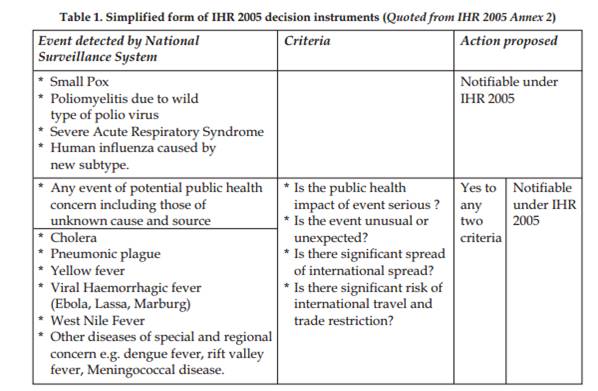The IHR are legally binding set of regulations adopted by WHO which helps countries to save lives caused by diseases spread internationally and other health risks.
History of the IHR
• The cholera epidemics that overran Europe between 1830 and 1847 were catalysts for intensive multilateral cooperation in public health
• in 1951 WHO Member States
– adopted the ‘International Sanitary Regulations’,
– Which were replaced by and renamed the ‘International Health Regulations’ in 1969.
• The 1969 IHR were primarily intended to monitor and control six serious infectious diseases:
– cholera,
– plague,
– yellow fever,
– smallpox,
– relapsing fever and
– typhus
• The notifiable diseases were only three:– meaning that States are required to notify WHO if and when these diseases occur on their territory
1. Cholera,
2. Plague and
3. Yellow Fever
In the early 1990s,
– the resurgence of some epidemic diseases, such as
• cholera in parts of South America,
• plague in India and
– the emergence of new infectious agents such as Ebola hemorrhagic fever,
• resulted in the 48th World Health Assembly in 1995, calling for the revision of the Regulations
The World Health Assembly adopted the IHR (2005)
Why were the IHR revised?
The limitations of the IHR (1969), which led to their revision, were
– Their narrow scope (only three diseases),
– Their dependence on official country notification, and
– Their lack of a formal internationally coordinated mechanism to contain international disease spread.
Also:
– In recent decades, cross-border travel and trade have increased
– News spreads rapidly via a multitude of formal and informal channels.
– New challenges have arisen in the public health control of emerging and re-emerging infectious diseases.
• With its focus on just three diseases (cholera, plague and yellow fever), the IHR (1969) were not equipped to address the growing and varied public health risks that resulted from increased travel and trade
• In addition,
– Some countries were reluctant to promptly report outbreaks of these diseases for fear of unwarranted and damaging travel and trade restrictions.
• A way was needed to increase the confidence of countries in reporting significant or unusual disease events, by linking early disclosure to prompt support and accurate information dissemination.
Notifiable Diseases under IHR 2005
1. ANY case of the following 4 diseases:
a. smallpox,
b. poliomyelitis due to wild-type poliovirus,
c. SARS and
d. Cases of human influenza caused by a new subtype.
2. Any event of potential international public health concern, including
a. those of unknown causes or sources
b. Even if not listed in points 1 or 3
*The State shall use the algorithm provided by WHO to assess risk of international spread, If considerable, to notify this ‘Public Health Emergency of International Concern’
3. Cases of the following diseases only If there a significant risk of international spread (requiring travel or trade restrictions), if yes, then to be notified to WHO
1. Cholera
2. Pneumonic plague
3. Yellow fever
4. Viral haemorrhagic fevers (Ebola, Lassa, Marburg)
5. West Nile fever
6. Other diseases that are of special national or regional concern, e.g.
7. dengue fever,
8. Rift Valley fever, and
9. meningococcal disease
The IHR (2005)
• Broaden the scope of the 1969 Regulations to cover
– existing,
– new and re-emerging diseases, including emergencies caused by non-infectious disease agents
• The IHR (2005) contain a range of innovations, including:
– A major change in IHR 2005 is introduction of new legal event ‘Public Health Emergency of International Concern (PHEIC)’
By not limiting the application of the IHR (2005) to specific diseases, it is intended that the Regulations will maintain their relevance for years to come even in the face of the continued evolution of diseases and of their transmission factors
– The establishment of National IHR Focal Points and WHO IHR Contact Points for urgent communications between States and WHO.
– Authorizing WHO to take into consideration unofficial reports of public health events and to obtain verification from States
The purpose and scope of the IHR (2005) are
• “to prevent, protect against, control and
• provide a public health response to the international spread of disease
• in ways that avoid unnecessary interference with international traffic and trade.”
What is meant by a "Public Health Emergency of International Concern” in the IHR (2005)?
• It refers to an extraordinary public health event which is determined (under specific procedures)
– to constitute a public health risk to other States through the international spread of disease; and
– to potentially require a coordinated international response.

References:
• Park’s Textbook of Preventive and Social Medicine, 23rd Ed.
• WHO, 2016. International health regulations (2005) -- 3rd ed. WHO Press, Geneva
• Singh Sujeet Kumar, Kumar Sudhir. International Health Regulations: A Major Paradigm Shift from 1969 to 2005; J. Commun. Dis. 41 (2) 2009 : 113-116
acculturation: http://www.ihatepsm.com/blog/acculturation
Social security: http://www.ihatepsm.com/blog/social-security
Operational research: http://www.ihatepsm.com/blog/operational-research
Gross National Income (GNI) and Purchasing Power Parity (PPP): http://www.ihatepsm.com/blog/gross-national-income-gni-and-purchasing-po...
Global Hunger Index (GHI: http://www.ihatepsm.com/blog/global-hunger-index-ghi
Hidden Hunger: http://www.ihatepsm.com/blog/hidden-hunger
International Health Regulations 2005: http://www.ihatepsm.com/blog/international-health-regulations-ihr
